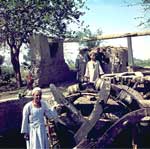 | | 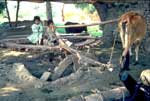 | |  |
| |
Sâqiya near Cairo
In this instance, the traditional pots are replaced by wooden boxes. Photo from 1964.
[114] | | Sâqiya near Luxor in Egypt
The two children have an important job to do. They look after the ox and yell [horses!] at it , if it takes a short rest.
[115] | | Sâqiya near Luxor
The pot on the right is new, but its shape can be traced back to the second century A.D.. It is easy to identify as the sâqiya pot has a knob at the bottom. A cord is fastened to the knob and then to the two endless ropes.
[116] |
|
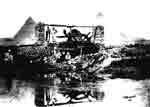 | | 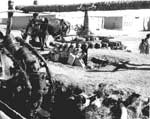 | | 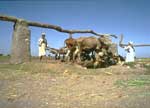 |
| |
Photo from 1920 taken near the Pyramids
From this picture, we can easily get the idea that the sâqiya was invented at the same time as the Pyramids were built. This is far from the truth. The sâqiya was invented in Alexandria around the first century B.C.. It was based on the same knowledge as survives in the old Greek manuscripts dealing with pure mechanics.
[117] | | Sâqiya operating in the Sudan
Some historians claim that agriculture was almost unknown in the Sudan before the invention of the sâqiya.
[118] | | Sâqiya with a pair of oxen in the Sudan
Draught-animals in the Sudan are often underfed. They are so weak that a pair of oxen are needed. Moreover, an ox-driver is needed to force them to work. If the animals are strong and healthy, there is no need for an ox-driver.
[119] |
|
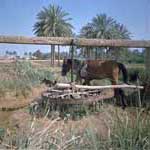 | | 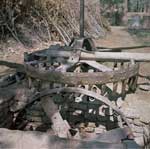 | | 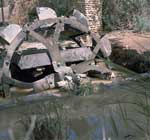 |
| |
Sâqiya near Babylon in Iraq
In Iraq, most of the sâqiyas are made of iron. In some cases, the oxen are replaced by a horse. The preferred draught-animal for the sâqiya is the camel, the buffalo, the ox, the mule or the donkey.
[120] | | Sâqiya near Babylon in Iraq
This iron-work construction from Iraq is more or less a copy of the sâqiya made in wood.
[121] | | Sâqiya near Babylon in Iraq
All the parts are of iron. We are in Iraq at a time when the river Euphrates overflows its banks. This means that there is no need for water lifting during that period.
[122] |
|
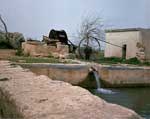 | | | | |
| |
Sâqiya in Syria
Normally the power-source is a draught animal, but some prefer a combustion engine. It is fascinating to note that the right-angle gear suits the speed of the draught animal. If the animal is replaced by a motor, a large gearbox has to be added between the animal and the engine.
[123] | | | | |
|